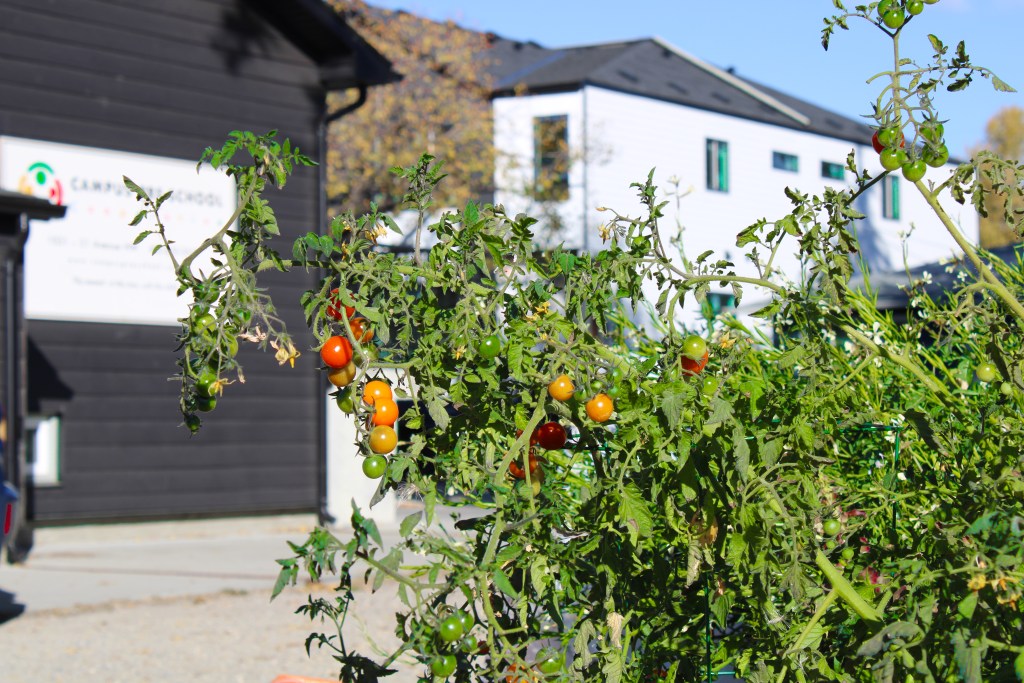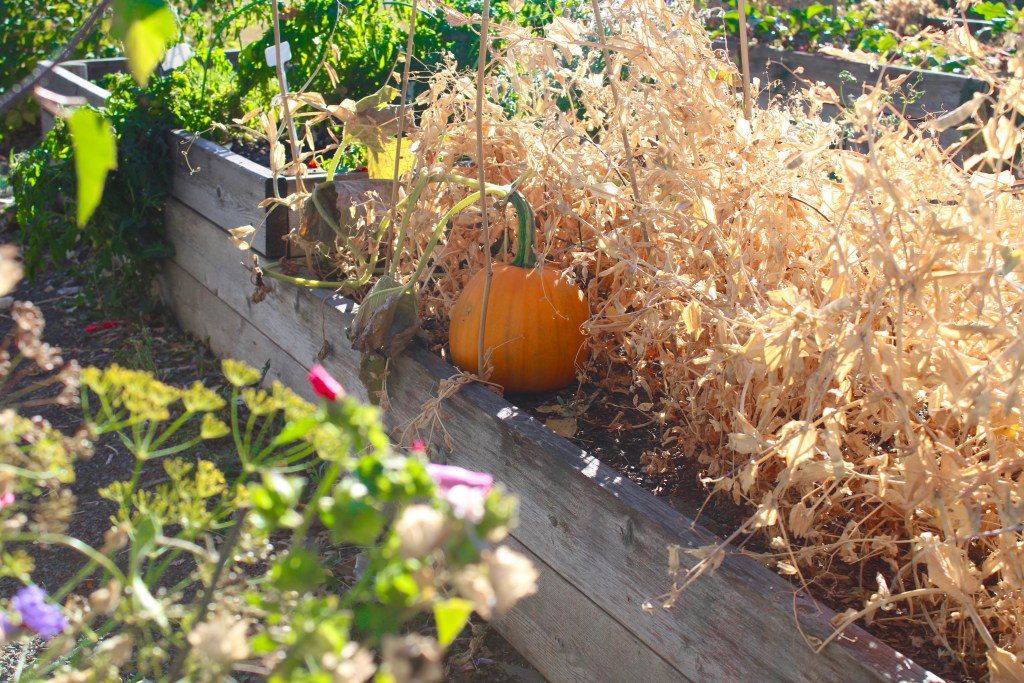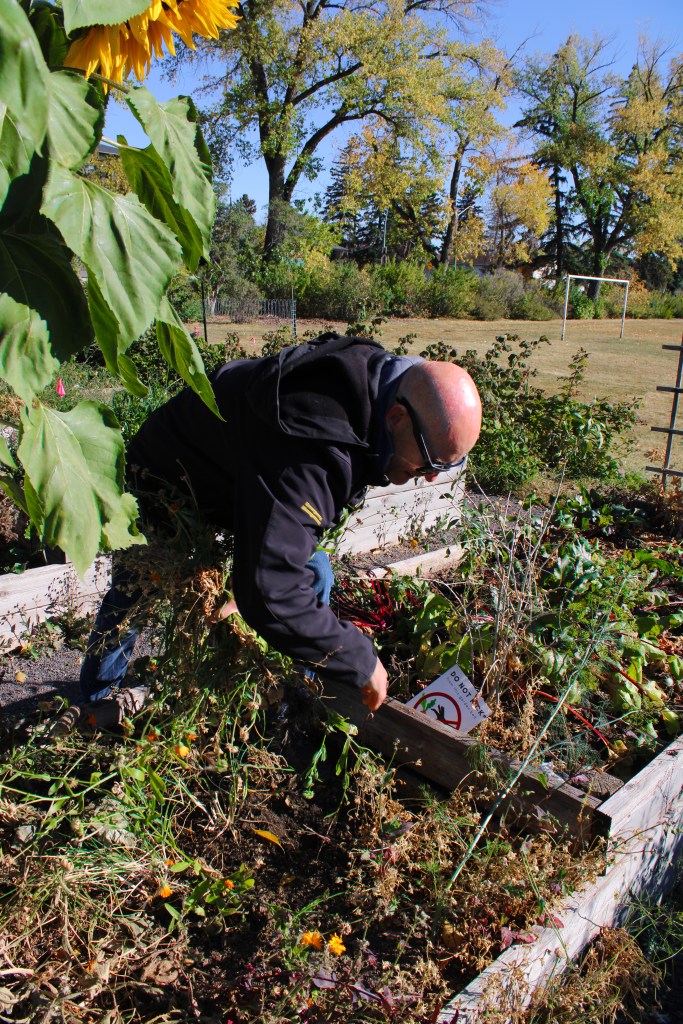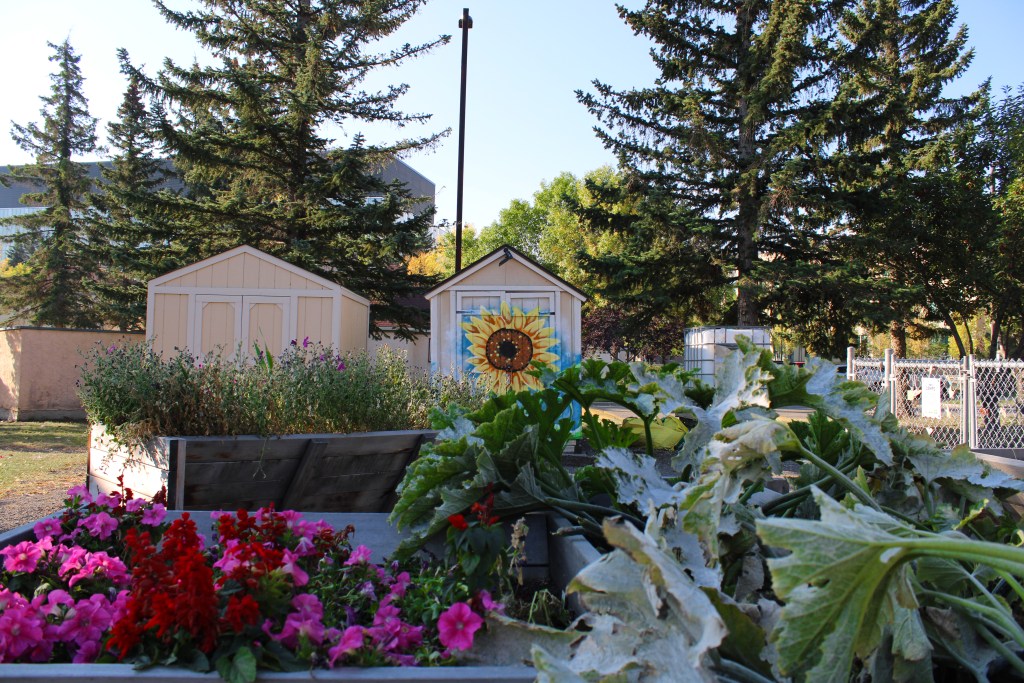The garden beds in front of Mount Royal University’s (MRU) east residence sit in quiet contrast to the busy campus around them.
Their wooden boards are sun-bleached and splintering, the edges soft from years of casual use without consistent care.
Earlier this spring, children from the Early Learning Centre filled them with herbs, flowers and various produce, their small handprints visible throughout the garden.
 Jamie Dardarian, Mount Royal University’s sustainability specialist, sits in the community garden outside Mount Royal University east residence. She’s leading plans to revitalize the space as part of future campus sustainability projects. PHOTO: JULIANNA ADAIR
Jamie Dardarian, Mount Royal University’s sustainability specialist, sits in the community garden outside Mount Royal University east residence. She’s leading plans to revitalize the space as part of future campus sustainability projects. PHOTO: JULIANNA ADAIR
Now, some beds sit empty while others overflow with tangled foliage.
Students walk past daily without acknowledging the garden, silently waiting to be cared for again.
“I think people are very disconnected nowadays as a result of COVID and technology and just everyone being so busy and working so much,” says Jamie Dardarian, sustainability specialist at MRU. “I see community gardens as a really nice intersection.”
While reflecting on what the space was, and what it could be, she says it’s a patch of potential on campus that needs hands, time and care. For now, there are no confirmed plans for its future.
“They’re often most successful when you have groups who are really knowledgeable and really passionate and keen, and [who] are willing to learn and get their hands dirty,” says Dardarian.
Because when that passion fades, so does the garden.
Beyond the harvest
Although management can be challenging, advocates say community gardens are a beneficial, sustainable space for communities to connect with each other, the environment and the food they consume. Through resource sharing and building relationships, they help people feed one another in ways that go beyond food.
A 2020 Canadian Food Studies analysis found community gardens strengthen social connection and well-being, but noted their actual food output is rarely measured.
Across Canada, the idea that community gardens can fix food insecurity has been echoed through city documents and funding pitches. But Chelsea Rozanski, a sessional instructor at the University of Calgary and co-convener of the Foods Studies Interdisciplinary Research Group, says that narrative overlooks the reality of hunger.
“When we’re really talking about food insecurity, you need to feed yourself and your family three times a day, substantial meals,” says Rozanski.
“That’s not often the kinds of foods that are grown in community gardens. It’s like, ‘Oh yeah, well, we can enjoy a nice salad here.’ But lettuce isn’t going to fill your belly up all through the winter.”
 Tomatoes ripen in the Capitol Hill Community Garden. The garden brings together residents of all ages to learn about gardening, share harvests and build community. PHOTO: JULIANNA ADAIR
Tomatoes ripen in the Capitol Hill Community Garden. The garden brings together residents of all ages to learn about gardening, share harvests and build community. PHOTO: JULIANNA ADAIR
She says the “food security” label on community gardens can often shift the burden from governments to people.
“It’s kind of them saying, ‘okay, well now we have this group of volunteers and they’re willing to put in the work and provide it, so then we can wipe our hands,’” says Rozanski.
That doesn’t mean community gardens don’t matter. Their value, Rozanski argues, lies elsewhere.
“They have the potential to be these really nourishing hubs of learning, of exchange,” she says.
“Although you’re coming together around gardening, that just opens the door to then doing things like sharing cultural crafts or dances or songs.”
A growing network across Calgary
That connection plays out daily across the 92 community gardens in Calgary, according to Calgary Horticultural Society’s directory.
Sign-up for our free newsletter and never miss a post from our student journalists
At Hillhurst Sunnyside Community Association, volunteers tend communal and private plots that support food donation programs like Made by Momma and Fresh Routes. Janet Sims, co-coordinator of the Kensington Community First Garden, says the garden’s strength lies in how it brings people together – whether they’ve lived there for decades or just moved to the neighbourhood.
“The gardens are so great because it makes people feel useful and like they’re contributing, giving back to the community,” says Sims.
“There’s always opportunities. Like always, next year is going to be better than this year.”
 A lone pumpkin sits among dried vines at the Capitol Hill Community Garden. The garden includes both private and communal plots, with blue-painted beds open for anyone to harvest from. PHOTO: JULIANNA ADAIR
A lone pumpkin sits among dried vines at the Capitol Hill Community Garden. The garden includes both private and communal plots, with blue-painted beds open for anyone to harvest from. PHOTO: JULIANNA ADAIR
That sense of purpose extends to the Capitol Hill Community Garden, where community means simply showing up, tools in hand.
“It just requires the organization skills for people to kind of come together and do it,” says Owen McHugh, director of the Capitol Hill Garden Group.
“I think it helps build community to bring people together of different age brackets. You get seniors through to young families. And to see things grow, I think is therapeutic for a lot of people.”
 Owen McHugh, director of the Capitol Hill Garden Group, tends to a raised bed in the Capitol Hill Community Garden. Supported by volunteers and a modest annual fee, the garden largely sustains itself without outside funding. PHOTO: JULIANNA ADAIR
Owen McHugh, director of the Capitol Hill Garden Group, tends to a raised bed in the Capitol Hill Community Garden. Supported by volunteers and a modest annual fee, the garden largely sustains itself without outside funding. PHOTO: JULIANNA ADAIR
Accessibility is key, McHugh adds.
“The idea is that it’s actually meant to be wheelchair accessible if people want,” he says. “Some people even share [garden] beds because maybe it’s too much for them to maintain alone.”
Further southwest, the Wildwood Community Garden is situated beside a skating rink, playground and school. Coordinators Pamela Gee and Carolyn Smith say it’s become “the jewel of Wildwood.”
“There’s so many aspects of the garden that get used by the community, and the community is very, very supportive,” says Gee, grinning at Smith.
“We have our families that we live with, but we also have our garden family.”
Over the years, Wildwood has become a gathering place for every stage of life, from weddings to grief circles. Their approach to sustainability is simple: care for earth, care for people, and share fairly.
“We always try to think of neighbours first in anything we need,” says Gee. “Like why would we get the compost from anywhere else when we’ve got someone to support in our neighbourhood?”
Wildwood’s design reflects those values of inclusion. Raised beds and wide pathways make it wheelchair accessible, and Smith says that access has mattered deeply.
“When we say accessible, we really mean accessible,” she says. “It’s a space for everyone, especially for people who maybe can’t normally get up close.”
Keeping the gates open, or not
Not all moments in Calgary’s community gardens are serene. Many face questions of theft, access and safety.
At Hillhurst Sunnyside, volunteers have dealt with stolen produce, vandalism and confrontations around access with the unhoused population. The gardens are now mostly fenced and locked.
“It’s not that we don’t want to make our gardens inclusive of people,” says Martin Robillard, Hillhurst Sunnyside Farmers’ Market Coordinator. “It’s just that we have a responsibility to our garden family.”
 Handmade hearts decorate the gate of Mount Royal University’s community garden, complementing the signage indicating the space is cared for by children through the summer – however, it’s unclear how students and faculty can be involved. PHOTO: JULIANNA ADAIR
Handmade hearts decorate the gate of Mount Royal University’s community garden, complementing the signage indicating the space is cared for by children through the summer – however, it’s unclear how students and faculty can be involved. PHOTO: JULIANNA ADAIR
Rozanski says those tensions reflect the broader realities of life downtown.
“In those inner-city areas, you see a higher percentage of theft or petty theft,” she says. “People are hungry and go to the garden. The need is there. The demand, the poverty.”
She’s seen urban gardens face even harsher conditions, finding broken glass, syringes and drug paraphernalia.
Further north, McHugh prefers to keep Capitol Hill’s garden open.
“Some will be like, ‘Why don’t we put a fence around it?’” he says. “That defeats the purpose.”
For McHugh, a community garden is a shared space meant to serve the greater good.
“Some people have grown carrots, then all of a sudden they have someone who’s pulled up a bunch of their carrots,” he says.
“I’m like, ‘Well, they probably needed them more than you, to be honest.’”
For all their successful harvests, season after season, these community gardens around Calgary depend on a few dedicated people willing to consistently lead and nurture them.
When those people move away or burn out, the gardens risk dying off.
“It’ll go along fine for a few years,” Sims says, “And then the key people who are looking after it move away or pass on, and it’s not easy to get it revitalized.”
A patch of potential
Back at MRU, Dardarian faces the same challenge. Even while juggling questions surrounding funding, material sourcing and student involvement, she’s optimistic about the garden’s future.
“It seems like there’s virtually nowhere you can go these days that’s free and just beneficial to your mental health and physical health,” she says. “You get to learn, you get to grow.”
 Late-season blooms and sprawling greenery fill some raised beds at Mount Royal University’s community garden. The quiet space still carries traces of community interest on campus. PHOTO: JULIANNA ADAIR
Late-season blooms and sprawling greenery fill some raised beds at Mount Royal University’s community garden. The quiet space still carries traces of community interest on campus. PHOTO: JULIANNA ADAIR
Her optimism reflects the same hope seen across Calgary’s successful gardens.
“You just have to stay focused on the good stuff,” Dardarian says. “And then work to create institutional change little by little. And the momentum grows – totally pun intended.”
And it does, one shared harvest at a time.
Related
Report an Error or Typo


Comments are closed.